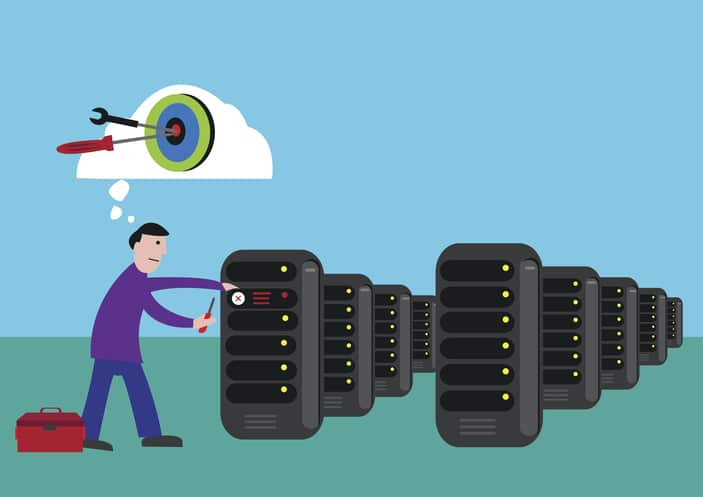Network Failover 101: SD-WAN & More
Is your network reliable and resilient enough to keep your business operating? If you’re putting up with a network that can’t meet your needs, then you need to make a change.
Connectivity and uptime are vital to a business’s productivity, profitability, and quality of service.
Without a strong Internet connection, so many of the tools a business relies on every day will lag and waste company time. VoIP-based phone calls to important business contacts will cut in and out, time-sensitive emails will sit in the outbox waiting for the connection before they can send, and cloud-based data will be inaccessible.
In short, an unreliable network leads to extensive downtime. Do you know just how bad downtime is for your business?

The High Cost of Network Downtime
Downtime is the term used for any period of time in which a computer or computer systems are offline and unavailable. Downtime can occur in a number of situations, all with varying degrees of severity:
- While you wait for the computer to restart in order to fix a problem
- After a power outage knocks out the entire building’s network
- In the fallout of a ransomware attack that encrypts all your company’s data
Downtime isn’t just expensive because you have to get your technology fixed — there’s also the fact that it brings your business’ operations to a halt. If an IT-related or natural disaster occurs and takes critical systems offline, employees will be unable to complete their tasks, yet your normal business expenses will carry on.
During that time, you still have to cover all the expenses of running a business without the revenue you would usually generate. Even if downtime does not grind everything to a halt, some of your staff will have to divert themselves from their normal work to mitigate the problem — again reducing productivity.
Here are some studies showing how much time is lost every day due to IT downtime:
- Average IT Downtime: According to a new survey of U.S. office workers, professionals waste 22 minutes each day, on average, dealing with IT-related issues.
- Average Time To Get Back On Task After An Interruption: A recent study indicated that most people take 23 minutes and 15 seconds to recover from an interruption.
However, average rates of downtime can vary greatly, depending on a number of factors:
- Industry: The more you depend on technology, the more likely you are to encounter downtime. For example, manufacturers encounter 800 hours of downtime every year.
- Size: The larger your business is, the more factors there are at play, and the more likely you are to encounter downtime.
- IT Management Practices: The better managed your IT systems are, the more likely you are to minimize the rate of downtime you experience.
No matter how much downtime you deal with, one thing we can all agree on is that it’s expensive. Ponemon Institute estimates that every minute of even partial downtime can cost as much as $5,600.
That’s why network failover capability is so important. Do you know what failover is?
What Is Failover?
Failover is the process of switching tasks from a failed system to a redundant, operational counterpart. In simpler terms, failover is what should happen when your network goes down — all associated tasks should seamlessly switch over to a redundant network so that you and your team can keep working.
Properly configured failover capabilities can ensure a cold spare version of networking architecture or components is ready to take over in the event that something happens to your primary network.
Types of failover include:
- Automated Failover: Failover execution without human intervention. This type of failover is important for critical systems like servers, systems, and networks.
- Manual Failover: This is when failover is executed with human intervention. This is often used for less important components and may require approval before failover can take place.
- Disaster Recovery Site: This is the ideal arrangement for failover, in which both the primary and the backup networks are running in parallel, with fully synchronized data at all times. This allows for truly seamless failover, with no lags or delays as data is backed up.
All of this goes to show why network resilience and failover capabilities are so important. That’s why many businesses are opting to use Software-Defined Wide Area Networking (SD-WAN).
Please note — if you don’t have a technical background, SD-WAN may be a confusing topic to explore. For direct advice from a team of experts, be sure to reach out to TLC Tech with any questions you may have about this technology and what it offers your organization.
What Is SD-WAN?
In the simplest terms, SD-WAN is a style of cloud computing that can change the way you handle network management, configuration, and performance.
Instead of a more rigid WAN network, SD-WAN allows you to configure your network quickly from a centralized location, reducing the potential of human error that can bring your network to its knees and productivity to a screeching halt.
Advantages include:
- SD-WAN is less expensive than traditional MPLS, an especially important point when you consider the bandwidth-heavy applications that business users require.
- Network availability is high because there is no need to take the network down to make configuration changes or upgrades.
- Your technology team is able to define networking rules in the language of business, making the network easier to understand and maintain in the future.
How Does SD-WAN Work?
Using a cloud-based controller, an overlay network is created in order to build encrypted tunnels, define applications, determine where sites are, and more. This portal/controller is the critical lynchpin, as it’s where you manage and operate the WAN from.
Benefits offered by SD-WAN include:
- Increased bandwidth
- Reduced cost for circuits
- Simple WAN management
- Improved user experience on applications
- Flexible security, whether that’s every single branch or just in specific “chokepoint” locations
SD-WAN Simple Architecture
While there are more complicated setups, most SD-WAN architecture is arranged with each plane tying down in order to affect the one below it:
- Orchestration Plane: While not present in every solution or necessary for every business, this plane allows businesses to automate certain functions.
- Management Plane: As the end-user of this solution, this plane is where you’ll set up your policies and templates, and handle configurations.
- Control Plane: This plane substantiates your intent onto the following data plane.
- Data Plane: This is the on-premise device at a given location, whether that’s a campus, a branch, etc. Wherever you would put your hardware.
How Does SD-WAM Integrate With The Cloud?
- Infrastructure as a Service (IaaS): Whether it’s Amazon Web Services (AWS), Azure, or another IaaS solution, you can put a virtual node in your VPC, and connect it to your SD-WAN as though it were just another site. Then you would go to your cloud portal on the Management Plane, and configure your policies as need be.
- Software as a Service (SaaS): This is even simpler to integrate with SD-WAN, which is why it’s the key area of adoption right now. Extremely popular solutions like Microsoft Office 365 are easy to set up with SD-WAN, and it’s highly recommended to support tasks like VoIP calling and remote working.
Essentially, you just set up a secure session, and it leaves the SD-WAN location at the data plane directly, and from there goes out to the subpart of the Internet where the SaaS provider is, and makes a secure connection over there — no need to set up tunnels. The key benefit is that your security policy can be pushed all the way down to the branch.
Is SD-WAN Right For You?
You may benefit from SD-WAN services if you are one of the following:
- An SMB that requires 24/7 inbound and outbound load balancing capabilities, whether it’s for VoIP, email, or SaaS solutions, or something else.
- A company with multiple locations tied to a central headquarters, all of which rely on a connection to centrally stored data.
- Web hosting or service providers that rely on Internet connections to deliver services and resources remotely.
- Remote working businesses that use VoIP, virtual desktops, and other deployed remote solutions.
- Companies that rely on cloud-based platforms and management solutions, such as ERP, UCaaS, CRM, etc.
How To Evaluate A Prospective SD-WAN Solution
When determining how well a given SD-WAN solution will serve your business, be sure to get the answers to these questions:
- What kind of topology and segmentation do you support?
- Does your solution integrate with my business’ current IaaS/SaaS platform?
- Do you offer Routing Protocol support for the migration process?
- What applications can you detect right from the start? What’s the process when you don’t detect a given custom app that my business and users rely on?
- Do you have the ability to add geographic chokepoints, say, for Internet service?
- Do you have strong Transport Independence?
- How does your Management Plane operate? Is it simple, flexible, streamlined? (If needed) Do you have Orchestration support?
- How do you handle key management between endpoints?
Need Expert Assistance Deploying Failover Capability With SD-WAN?
Not sure where to begin? Allow us to help.
TLC Tech offers SD-WAN and redundant network solutions that offer reliable failover capabilities. By configuring redundant, backup connections, we ensure that no calls drop, bandwidth and latency perform at optimal rates, and your business keeps moving at the pace you need it to.
Our team will assess your company’s current connectivity and related business needs, research the options best suited to you, and then help you make the right choice.

